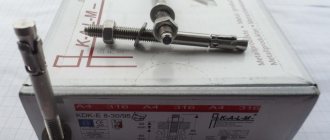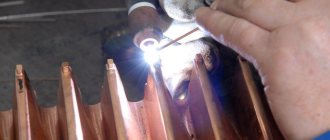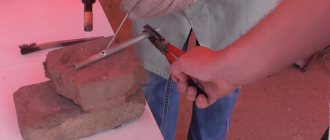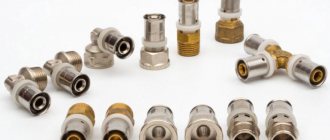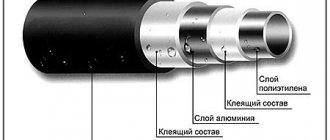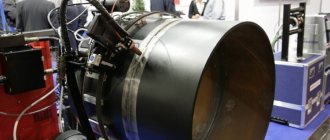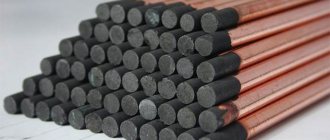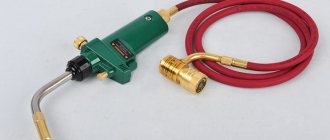Why copper water pipes?
A large selection of materials for installing a water supply, heating or air conditioning system gives you the opportunity to choose: plastic, metal-plastic, steel, copper. Practicing plumbers are confident that the best choice is copper pipes, which are superior in properties to other materials:
- operation of copper pipelines with different temperature conditions, from low to high;
- resistance to mechanical loads;
- inertness to aggressive environments;
- durability;
- resistance to oxidative processes;
- compatibility with interior design.
These performance characteristics make the material in demand when installing engineering systems for apartments, houses, cottages and offices.
Features of the installation of copper pipelines
Copper piping in the device does not cause any particular problems. But there are certain nuances that involve a departure from standard connection methods, the use of soldering and special tools. It is also necessary to take into account the plasticity of the material, which allows the master to bend a pipe of the desired configuration without using equipment or tools.
Conventional welding for steel pipes is not suitable for copper pipes, since copper has a lower melting point than steel. For soldering, use a low-temperature gas torch or a powerful soldering iron.
In order to obtain the required diameter when connecting, use a pipe expander for a copper pipe.
How to choose the right one
Determine a suitable model based on the following data:
- Scope of future processing.
- Type of material, maximum and minimum cross-section of bends for cutting which the pipe cutter will be designed.
- Quality of pipe cutter and blade.
- The amount allocated for the purchase.
It is clear that cheap devices are only suitable for one-time household work.
For more serious and frequent tasks, it is better to choose reliable tools from well-known companies at suitable average prices.
Mechanical or electrical
To work with copper pipes, get hand-held pipe cutters.
Copper pipes are much softer than steel pipes and do not require much physical effort when cutting. Their diameters are not large: the most common are 15 and 22 mm
It is important to feel the thin and pliable metal with a hand tool. This is necessary when working with tubes from refrigerators and air conditioners, with annealed copper pipes of small diameters
Power tools are necessary for large volumes, in industrial production conditions, when processing thick-walled pipes. Their cost is significantly higher than the most expensive manual pipe cutter.
How to choose a blade for a tool
The cutting edge in a pipe cutter is the main link; the speed and quality of the cut depends on its sharpness and stability. The blade is a consumable item; it becomes dull quickly and must be replaced on time.
When choosing a blade, pay attention to the following points;
- Material of manufacture. It should be alloy steel, preferably stainless steel.
- Sharpening angle. If the disc is sharp, it cuts quickly, but is prone to distortions. An obtuse angle provides resistance to distortion, but the cut will require additional processing.
- Correspondence of the blade to the standard dimensions of the pipe cutter model.
- The height of the roller for cutting copper is 3.5 and 5.5 mm.
Approximate price
The cost of the simplest manual pipe cutters starts from 350-400 rubles.
The average price of a high-quality and stable instrument is 1000-3000 rubles.
The cost of a good professional device starts at 3.5 thousand.
Industrial machines from world brands reach prices of 200-300 thousand.
Product design features
Pipe expanders are sold from simple manual samples used in everyday life to complex electronic modules used in industry.
The manual pipe expander consists of:
- base element;
- clamps and clamps;
- handle;
- nozzle heads;
- element for transmitting force.
The base material is steel with one or more tubes that have different diameters and are fastened together. The tubes are equipped with handles for gripping. At the top of the tool there is a head on which the attachments (attachment) are placed. The nozzle rotates or expands. A simple tool does not provide for changing attachments, and the expansion is done by the head.
Modification of nozzles is different. These include round metal rings, which slightly change the diameter by applying pressure on the handle, and a complex petal tool.
In manual models of pipe expanders, springs transmit torque. But there is a tool that is equipped to transmit forces using an electric drive, hydraulics, etc.
Types of pipe expanders
This tool may have a number of features, depending on what kind of work it is intended for. For example, to install store equipment, such as slides or islands, a pneumatic type of pipe expander is very useful. Many teams use this tool and keep it on hand.
We recommend: Taps for polyethylene pipes
Pneumatic
It looks like this:
Here is another photo of the instrument, how it looks in the hands.
Let's look at how this view works. A special head, about an inch in size, is screwed onto it; the diameter is selected directly for the tool. We press the lever and the pipe begins to expand. Works with pipes of different diameters, starting from 3/8 and increasing. It happens that the kit does not include the required head; most often, large sizes are missing. In this case, you can buy them separately, this is not a problem. For example: we had a similar moment. Heads with diameters of 5/8 and 1/8 were required, but they were not available. I had to go to stores. This is not a good thing, as additional costs will be required. The next tool that will be discussed has many similarities with a pneumatic expander. This is a manual type of pipe expander. Their principles are almost the same. The main difference is that it is represented by mites; they must be removed manually. Let's look at a manual pipe expander with the head removed.
The same tool, but it has a head on it.
In working order, there is a second head nearby.
The photo shows the folded handles and the expansion of the pipe.
This is what the heads for the tool look like, the diameter is inch.
It’s very advantageous that the handles are elongated, which means you don’t need to exert any effort, minimal effort – great results. The head is inserted into the pipe, then you can begin to expand it. It is enough to reduce the handles to only half of their total stroke, then loosen. Then you need to rotate the head inside the pipe, press the handles again, now at full speed. If we follow these simple rules, the pipe will expand as we need, but it will not explode.
How does a pipe expander work?
The operating principle of the expansion device is based on direct action on the pipe walls. The nozzle is inserted into the pipe hole and expansion is performed.
You also need to pay attention to the type of force used. These are springs in hand tools, and in hydraulic models the handle is pressed and liquid is supplied, which pushes the piston inside the device.
The electric drive on the expander is a small engine that generates energy to perform the job effortlessly. The only thing the user needs to do is select the nozzle and install the device in the desired position and turn it on. This is a productive tool that can work with copper pipes of different wall thicknesses. The electronic pipe expander is used only for industrial purposes. It is expensive, so there is no point in buying it for household needs.
Well, let's get started!
When working with copper pipes, first of all, we are faced with the need to connect them. To do this, there is special equipment - a steel coupling, an angle, a tee, they can be different in size and functional features. It is more convenient to connect some connections with a device called a pipe expander. Using this method, you need to expand one pipe. The hole must be the right size, the second pipe must fit tightly into it, and there must be no free space. It is necessary to count on the fact that the soldering process should proceed without problems. When a pipe is twisted in an air conditioning system, that is, in a coil, bending it is not difficult. Usually they are represented by already burnt pipes, so before starting expansion you won’t have to heat it with a burner for too long, at least not until it turns red. Non-burnt pipes are considered to be those supplied in lengths (5 m). This material cannot be expanded, as this will cause it to explode. Therefore, you need to thoroughly heat the pipe with a gas heating pad, and then try to bend it in the chosen place. To make the task easier, we burn this part to 40 centimeters in length. Therefore, you can create a bend at any angle that you require.
How pipes are soldered using an expander
The process of making connections using a pipe expander for copper pipes:
- Preparation of equipment and copper removal.
- The layers are cut in the required place and the burrs are cleared.
- Tool preparation.
- Machining the hole to the required diameter.
- If necessary, calibration is performed.
- Another untreated layer is inserted into the prepared and processed hole.
- Soldering joints.
- Complete cooling of the connection.
All actions take the master no more than half an hour, but without cooling down.
You should not forcibly cool the soldering area, as there is an increased risk of microcracks, which leads to leaks. It is advisable not to touch the soldering area for a day, but if the work is urgent, you need to wait at least two hours.
The expander can be used for fitting and collet connections.
Application when welding on fittings
- A copper cutter is used to cut the pipe to the required size;
- a deburring tool removes the chamfer from the outside and inside the end;
- the prepared edge is cleaned with Scotch Brite or fine-grained sandpaper from the outside of the fitting;
- such actions are also performed for the inner surface of the fitting connection;
- the cleaned pipe branch and part of the fitting are coated from the inside with paste or flux;
- the connected elements are clamped in a vice;
- Using an acetylene torch, we heat the connection, smoothly applying solder at the joint;
- After heating the copper, all excess solder is removed with a rag.
These actions are comparable to ordinary copper soldering using a pipe expander, but without a fitting connection.
The place where soldering was done is sanded with fine-grained sandpaper. In this place, at first the copper will be lighter, but during use it will darken and will not stand out against the background.
Push-in connection using a pipe expander
Expanders are actively used for collet fittings. Collets and fittings must be copper or made of an alloy, but must contain copper.
Place the union nut on the pipe along with the O-ring.
The cross section is flared and a fitting shank with rubber rings is inserted, which will provide complete tightness for the resulting connection.
At the final stage, the nut is simply tightened.
Compression press fittings
Press fittings made of copper or with a high copper content are also a connecting element when installing a copper pipeline. To carry out the work, you will need a special tool with which to perform crimping. The work procedure for the connection device is very similar to the collet connection, but there are slight changes. In this case, we do not use a collet fitting, which has an O-ring and a union nut, but a similar element that has a soft sleeve that encircles the pipe along its entire diameter. The result is a connection that cannot be disassembled and is very durable.
Scheme of work:
- To cut the pipe, a pruner is used, and the cut itself is made at a right angle;
- along the cross section it is necessary to chamfer both outside and inside;
- the hole needs to be flared;
- the layer is put on the fitting shank followed by a stop;
- crimping pliers secure the connection.
The connection is not removable; do not begin work without first checking all dimensions. It can't be fixed, you'll have to buy a new set.
Features and Tips
It doesn't matter which pipe will expand. It is clear that with different diameters, the pipe that has the larger diameter is used for expansion. This makes the process less labor-intensive, and the metal itself undergoes less deformation, which has a positive effect on its characteristics. This is important for all metals, including copper, which is ductile and malleable.
The pipe expands smoothly. The pressure is not jerky.
It is better to choose conical nozzles that, when rotated, gradually penetrate into the layer, expanding it.
Is calibration necessary? It all depends on how carefully you used the expander. In case of poor quality actions, calibration will be required.
Experts advise applying solder at least twice, excluding the incorrect belief that it will stick well anyway. When soldering, you need to monitor the temperature. With strong heating or, conversely, cooling, the pipe walls will be the first to react, making the already expanded diameter larger or smaller. Accordingly, the entire process using the expander is disrupted.
How to choose a pipe expander
How to use the tool, which type will be best for the job, its performance and versatility.
The tool market offers craftsmen various types of pipe expanders. In terms of performance, pneumatic pipe expanders are the best. The tool is expensive, but its capabilities are excellent. Consists of a head with petals. Compressed air entering it expands the walls of the pipe being processed until a hole of the required diameter is obtained. Replaceable heads are provided, making it possible to increase the diameter to the required dimensions. The main structural element of this tool is a pneumatic cylinder that provides pressure.
For small volumes, it is advisable to use a manual pipe expander, which is similar to pliers. Its arms are long and act like levers.
Conclusion
Rolling (expansion) of copper pipes is a simple process accessible to anyone. But as in any other business, experience and skill are needed. It is necessary to practice with pipes of different diameters in order to subsequently obtain a tight and durable connection.
Master plumbers working in this direction need a professional tool or set that allows them to work quickly, with minimal labor costs.
For household work, a simple expander is useful, which has only a few attachments, which will be enough to install a water supply system or heating system.
Self-flaring using an expander makes it possible to obtain the desired pipe diameter on the pipeline, without purchasing special machines or other equipment.
Range of pipe expanders
Expanders with replaceable heads
. The traditional version of the pipe expander, which is chosen most often. Many models allow not only to expand the pipe, but also to calibrate it after cutting.
Step expanders
. Optimal if necessary, often work with pipes of different diameters. They allow you to increase the speed of pipeline installation due to the fact that it does not have to be re-equipped each time when changing the pipe size.
Depending on the model, expanders can be used to expand pipes made of copper, aluminum and thin-walled steel.
